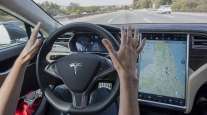Pentagon Might Obtain Self-Driving Vehicles First

Forget Uber, Waymo and Tesla: The next big name in self-driving vehicles could be the Pentagon.
“We’re going to have self-driving vehicles in theater for the Army before we’ll have self-driving cars on the streets,” Michael Griffin, undersecretary of defense for research and engineering, told lawmakers at a hearing on Capitol Hill earlier in April. “But the core technologies will be the same.”
The stakes for the military are high. According to Griffin, 52% of casualties in combat zones can been attributed to military personnel delivering food, fuel and other logistics. Removing people from that equation with systems that run on artificial intelligence could reduce injuries and deaths significantly, he added.
RELATED: Army tests autonomous truck driving systems
“You’re in a very vulnerable position when you’re doing that kind of activity,” Griffin said. “If that can be done by an automated unmanned vehicle with a relatively simple AI driving algorithm where I don’t have to worry about pedestrians and road signs and all of that, why wouldn’t I do that?”
Technology and auto companies including Alphabet Inc.’s Waymo unit and General Motors Co. are racing to develop autonomous vehicles to deploy in ride-hailing fleets. Uber Technologies Inc. has introduced self-driving trucks to U.S. highways on a trial basis in some locations. Waymo has been working on the technology for more than a decade, and most other companies have encountered significant hurdles, highlighted by the death of a pedestrian in Arizona who was struck by an autonomous Uber test SUV in March.
Beyond the technical challenge of engineering a car that can safely traverse chaotic city streets on its own, civilian self-driving developers must navigate a still-evolving legal and regulatory environment. Passenger vehicles must comply with scores of federal vehicle safety requirements governing everything from turn indicators to braking systems, many of which assume drivers will be human.
But the military’s autonomous vehicles won’t roam regulation-free just because they may be headed toward battlefields, according to Karlyn Stanley, a researcher and lawyer at the Rand Corp.
DARPA Research
“The regulatory structure here in the U.S. and the countries where the U.S. may be sending troops are very different,” Stanley said. “How autonomous vehicles are going to be regulated — in terms of safety, cybersecurity, privacy and liability — those are going to be critical issues” the Pentagon will have to address as well, she added.
RELATED: Platooning advances in Michigan
The Pentagon has a long history of support that helped to develop or refine key technologies that become widespread later, including space flight and the internet.
Griffin said the Pentagon “absolutely must leverage” what private companies are doing to develop self-driving cars, though he didn’t mention any by name and his office declined to comment when asked for more details about the Pentagon’s plans.
The Defense Advanced Research Projects Agency, which Griffin oversees, has been funding research into self-driving cars for years and sponsored its first competition for the vehicles in 2004.
“The military is very eager to learn and build upon what’s been done commercially as opposed to try to reinvent and do it themselves,” Rand’s Stanley said.
$700 Billion
With an annual budget of almost $700 billion, the Pentagon can afford to aggressively pursue autonomous vehicle technology well beyond fuel and food delivery trucks. The Army, for instance, is pushing forward with efforts to develop unmanned tanks and smarter vehicles for bomb disarmament, though many of those technologies will be remote-controlled, not autonomous.
Major Alan L. Stephens, an officer at the Mounted Requirements Division of the U.S. Army Maneuver Center of Excellence in Georgia, said in December that the Army wants to start testing light, fast remote-controlled tanks with the same firepower as the current 70-plus-ton manned M1 Abrams tank within the next five years.
BAE Systems, the maker of the Army’s manned Armored Multi-Purpose Vehicle, also makes unmanned vehicles known as the Ironclad and the Armed Robotic Combat Vehicle. The Ironclad, which looks like a miniature tank missing a gun turret, is expected to have roles in reconnaissance, evacuations of injured personnel and explosive ordnance disposal, according to the London-based company’s website.
Pilotless Submarines
Offshore, the Navy is seeking help developing technology for the next generation of large and extra-large unmanned underwater vehicles to incorporate artificial intelligence so they can handle navigation hazards such as deep-draft commercial ship traffic, fishing activities, marine mammals and prospecting for oil, gas or minerals. Lockheed Martin Corp. and Boeing Co., the largest and second-largest U.S. contractors, are competing on the program, with a critical design review scheduled for December.
The effort to field autonomous vehicles in combat comes amid a broader push by the Pentagon to use technological innovation to “increase lethality,” in the words of Secretary of Defense Jim Mattis. But the implications of using technology in this way have raised the antennae of socially conscious employees at some of Silicon Valley’s biggest companies.
‘Enormous Pressure’
Thousands of employees at Alphabet’s Google recently demanded an end to deals letting the military use the company’s artificial intelligence technology. Mattis visited Google headquarters in Mountain View, Calif., last year to discuss with executives the best ways to use AI, cloud computing and cybersecurity for the Pentagon.
Among critics’ concerns is the potential development of autonomous weapons that make their own life-and-death targeting decisions. Ash Carter, who was defense secretary under President Barack Obama, told a Silicon Valley audience in 2016 that “in the matter of the use of lethal force, there will always be — at least speaking for the United States — a human being involved in decision making.”
Charles Dunlap, a retired Air Force major general and now a law professor at Duke University, said companies will come under “enormous pressure” as they sort out these issues and try to make sure their artificial intelligence products for the military don’t put people in danger.
“Self-driving vehicles for battlefield logistics resupply are obviously more benign than autonomous weaponry,” Dunlap said in an e-mail. “But it would still be legally and ethically necessary to demonstrate that they can be used without excessive risk to civilians who may be caught up in the fighting.”
With assistance by Cameron Leuthy




